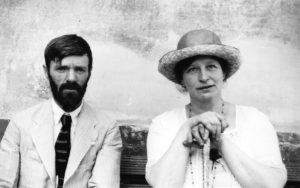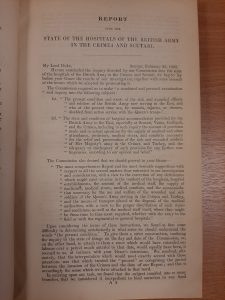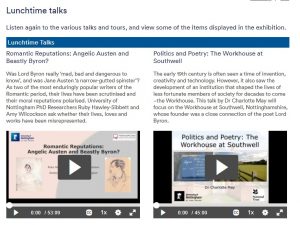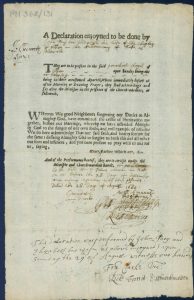January 12, 2021, by Kathryn Steenson
Year In Review
It might seem a little late to be doing a ‘year in review’ post, but as this year shows every sign of being a continuation of 2020, I think we can pause to look back over what Manuscripts and Special Collections did over the previous 12 months. Here’s a look at last year in numbers:
6: The number of in-person visitors to our ‘Florence Nightingale Comes Home’ exhibition at Lakeside Arts, on the one day we were able to open (there’s an online version here).
1,547: The number of pages of archive material digitised as part of the project ‘Unlocking the DH Lawrence Collection: cataloguing and digitisation for research and display’. Although the April start was delayed by the lockdown the project will run for two years. By the end all the Lawrence literary manuscripts, letters, typescripts, proofs and works of art will be digitised.

D.H. Lawrence and Frieda Lawrence sitting on a bench in Chapala, Mexico. The photograph was taken by Witter Bynner in 1923.
714: The number of enquiries we received. When lockdowns were eased, a handful of staff were able to access the collections even when the Reading Room was closed. This meant we could still fulfil copying orders or look-up information for researchers who couldn’t visit.
23: The number of new accessions. We take in new archival material all the time but, as is to be expected, this is a lower number than usual. More records were donated from St Andrew’s with Castle Gate United Reformed Church in Nottingham, and we took in a new collection of the papers of Matt Marks, a musician, composer and performer who sadly died in 2019 aged just 38. We also purchased two first editions of reports written by Florence Nightingale relating to the history of nursing and hospital sanitation, to support the Florence Nightingale exhibition.

Report upon the state of the hospitals of the British Army in the Crimea and Scutari, together with an appendix (1855). Ref: 1008237510
50,449: The number of hits our blog received (for the curious, the most-viewed post was this one about the Nottingham Blitz – appropriate, for the year of the 75th anniversary of VE Day).
204: The number of Archdeaconry penances indexed online. They are part of this group dating between 1628 and 1641, and records a public display of repentance by people who had committed a moral or religious offence under Church law. There are many thousands of penances and indexing them is normally done by staff as a background task, which helps family and social historians to find relevant information.
285: The number of visits to the Reading Room by UoN staff and students, for in-person research, despite being closed for several months and capacity being reduced to just six due to social distancing measures. Although we were completely shut for the March lockdown, we are still open during this current lockdown.
51: The number of talks from our exhibitions that have been subtitled and uploaded to the website. The automatic captioning software is reasonably good, but struggles with things like people’s and place names. Staff manually corrected them, and learned a lot about forests, British India, and romanticism in the process.
22,000: The number of historic conservation records on paper files into a spreadsheet. Each entry relates to a document or book that has been cleaned or repaired by the Conservation team, and shows what work was carried out, and the materials and techniques used. This is another background task, of more benefit to staff than for researchers, which was finally completed during the long stretch when we weren’t able to go into campus.

Manuscripts and Special Collections holds the rare books and archives collections the University of Nottingham. Please check our website for how to contact us and the latest on accessing the collections.
No comments yet, fill out a comment to be the first


Leave a Reply